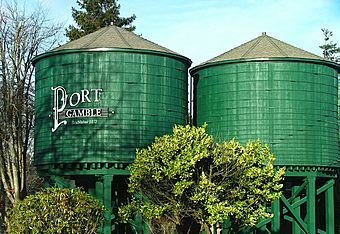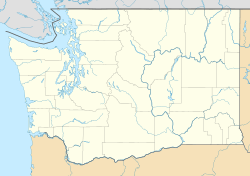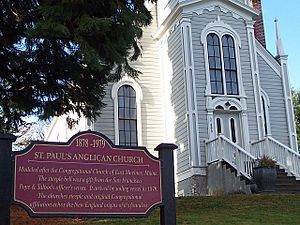Port Gamble, Washington facts for kids
|
Port Gamble Historic District
|
|

Water towers in Port Gamble
|
|
| Location | Port Gamble, Washington |
|---|---|
| Built | 1853 |
| Architectural style | Greek Revival, Late Victorian |
| NRHP reference No. | 66000746 |
Quick facts for kids Significant dates |
|
| Added to NRHP | November 13, 1966 |
| Designated NHLD | November 13, 1966 |
Port Gamble is a small community in Kitsap County, Washington, United States. It sits on the northwestern shore of the Kitsap Peninsula. The community is named after a small bay nearby. This bay is close to the entrance of Hood Canal.
Port Gamble is known for its historic buildings. It is one of the best-preserved old lumber towns in the western United States. Because of its history, the Port Gamble Historic District is a U.S. National Historic Landmark.
Today, Port Gamble is a popular place for tourists. It has many unique shops, like antique stores and a tea shop. There is also an old-fashioned general store. The town is close to other popular places like Bremerton and Seattle. Port Gamble is also home to the grave of Gustave Englebrecht. He was the first U.S. Navy sailor to die in the Pacific Ocean.
Contents
History of Port Gamble
Gamble Bay got its name in 1841 from the Wilkes Expedition. The exact reason for the name is not fully clear. One story says that a survey team camped near some Suquamish and Clallam Native Americans. These groups were meeting to gamble for blankets all night. This event might have given the bay its name.
The community was first called Teekalet. It was later renamed Port Gamble, after the bay. The town was started in 1853 by the Puget Mill Company. This company was owned by Josiah Keller, William Talbot, and Andrew Pope. Port Gamble was a "company town." This means the company owned most of the buildings and businesses.
In 1856, the USS Massachusetts came to Port Gamble. It was sent to help local Native Americans. They were being attacked by groups from other territories. The first school in the county opened in Port Gamble in 1859. The town officially took its current name in 1868. In 1966, Port Gamble became a National Historic Landmark District.
The original mill closed in 1995 after 142 years. This made it the longest-running sawmill in the country.
How Port Gamble Was Founded
In 1849, William Talbot and Andrew Pope came to San Francisco. They wanted to join the growing lumber business there. They saw that the West needed a lot of wood for building. They heard about the thick forests in the Oregon Territory. So, they formed the Puget Mill Company with Josiah Keller and Charles Foster. Their goal was to get lumber for the expanding West.
In 1853, William Talbot found a great spot for a mill at Gamble Bay. It was near many trees and had a good port for shipping lumber. Soon after, Josiah Keller joined him with the mill's equipment. By September, the new mill was already cutting logs into lumber.
It was hard to find enough workers for the mill. The Pacific Northwest was a wild frontier with few people back then. So, the company brought experienced mill workers from Maine. These workers missed their homes. To make them feel more comfortable, the houses built for them looked like those in New England. This is why many buildings in Port Gamble have a New England style.
The S'Klallam people had lived in the Gamble Bay area since 2400 B.C. They were the first to live there. In 1855, a treaty was signed that allowed non-Native settlers to live on the land. By then, the S’Klallam people had moved across the bay to Point Julia. The mill company made an agreement with them. The S’Klallams got jobs at the mill and lumber to build new homes and a school. This new community became known as Little Boston.
Tree Farms and Forests
As the Port Gamble mill grew, it needed more and more trees. The Puget Mill Company bought a lot of timberland. By 1892, they owned 186,000 acres of forest. Other states were running out of trees, so more companies looked to Washington for lumber. By 1906, Washington had over 900 sawmills.
Soon, Washington's old forests were also shrinking. People realized they needed new ways to get wood. In 1941, the first certified "tree farm" was started in Washington. It was called the Clemons Tree Farm. The Puget Mill Company, later called Pope & Talbot, Inc., started its own tree farm in 1946. By 1953, their Hood Canal Tree Farm had 75,000 acres.
Tree farms help make sure there is always wood for products. As Gifford Pinchot, a famous forest expert, said, "Wood is a crop, Forestry is Tree Farming." This means that trees are like other crops, such as corn or wheat. They need to be planted and cared for so we don't run out of them.
Port Gamble's Economic Growth
In the mid-1800s, California had a huge economic boom. This was because of the California gold rush. Many people moved to California, and they needed a lot of building materials. California looked to the Oregon Territory for timber and other resources.
William Talbot, Andrew Pope, and Josiah Keller found a lot of timber on the Olympic Peninsula. Talbot and Pope were already big in the lumber business. They worked together to build the mill in Port Gamble. This mill became the longest-running lumber mill in North America. It also had a big impact on the global timber industry.
Port Gamble became a major lumber supplier worldwide. The Puget Mill Company shipped wood from the Olympic Peninsula to 37 different ports. These included places as far away as Shanghai, China, and Cape Town, South Africa. By 1862, the company owned ten ships. They were shipping almost 19 million board feet of lumber overseas.
Around the year 1900, the Puget Mill Company and Pope and Talbot Lumber Company shipped lumber across the Atlantic Ocean. This wood was used by the British, French, and Russian navies for their ships. Captain Keller helped plan these shipments. He created routes along the Pacific Coast to meet the high demand from the California Gold Rush. This also opened doors for shipments to China and Southeast Asia. Because Talbot and Pope were from Maine, they also had connections to the East Coast. This helped them ship lumber to South America and the West Indies.
Sale of Puget Mill Company
In July 1925, the leaders of the Puget Mill Company decided to sell the company. William H. Talbot had already decided a year earlier that the mill should stop making lumber once all orders were filled. The company had faced many challenges. In 1907, Washington state increased taxes on timberland. The mill also had old equipment and needed repairs. All these problems made it hard for William Talbot to keep the company going.
Charles McCormick of the Charles McCormick Lumber Company bought the Puget Mill Company for $15 million. This was a big change because the company had been owned by the Pope and Talbot families for almost 100 years. Even though the company was sold, Talbot made sure the Port Gamble Mill would stay open. He made McCormick agree to build a brand new mill in Port Gamble.
Creation of Pope & Talbot Co.
Charles McCormick did not have much success as the new owner. Building the new mill in Port Gamble and improving other mills cost a lot of money. By 1938, McCormick owed over $7 million to the original owners. He could not make the payments. So, he had to give all the company's properties back to the descendants of the original founders.
By 1940, George Pope, Sr., another descendant of the Pope family, was leading the company. They decided to rename the business Pope & Talbot Mills. When the U.S. entered World War II, Pope & Talbot Mills became very busy. The mills ran at full speed during the entire war. The company's ships helped transport important supplies to battle areas like Guadalcanal and Okinawa.
Preserving Port Gamble
Many buildings in Port Gamble are well-kept historical sites. Most of the town is still owned by the mill company today. There is an old church called St. Paul's Episcopal Church. It was built in 1870 and looks just like a church in East Machias, Maine. Many buildings in Port Gamble show the style of architecture from Maine. This is because the early settlers, like Pope and Talbot, came from there.
The National Park Service has called Port Gamble "the finest example of a nineteenth-century Pacific Coast logging community." The Port Gamble Historical Museum tells the story of the town. It shows how the Pope and Talbot mill shaped the community. The general store was one of the first buildings. It sold many things like coffee, tools, and toys to workers, settlers, and the S'Klallam tribe.
A general store still stands in the town today. It has been restored to look like it did in 1916. It is now a popular spot for tourists. The town also holds an Old Mill Days festival. This event helps keep the spirit of the old mill alive. Visitors can get pamphlets for a walking tour to see the historic buildings.
The effort to preserve Port Gamble began in the mid-1960s. Pope & Talbot rebuilt and restored thirty houses and buildings. They also put power lines underground and installed old-fashioned gas street lamps. In 1966, Port Gamble was officially named a National Historic Landmark. One of the oldest houses still standing is the Thompson house, built in 1859.
Events in Port Gamble
The annual Old Mill Days festival happens over three days in early July. It takes place throughout the downtown area. The event includes craft and food stands, a logging show, fireworks, and other fun entertainment.
Port Gamble in Popular Culture
Port Gamble was the setting and filming location for the 2010 movie '. The Walker-Ames House and Port Gamble were also used for a supernatural horror film called “Squatter.” Best-selling author Gregg Olsen used Port Gamble as the setting for his "Empty Coffin" book series. This series includes books like "Betrayal" and "Envy."
See also
 In Spanish: Port Gamble Tribal Community (Washington) para niños
In Spanish: Port Gamble Tribal Community (Washington) para niños





